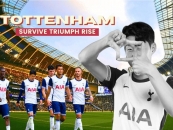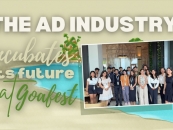-853X543.jpg)
How marketers can think about a Post - COVID-19 world
by Mahesh Murthy April 22 2020, 1:07 am Estimated Reading Time: 12 mins, 6 secsPerhaps it may be a little too early to say this, but we may be reaching peak lockdowns in many places around the world. The curves aren’t flat yet – but they might be beginning to level off. As a species, we might be seeing the light at the end of the Coronavirus tunnel, writes Mahesh Murthy
In May 2020 or June 2020, the lockdowns will wind down. And the people on this planet will start crawling back out again from all the safe places they’ve been hiding these past few weeks.
Here's ten thoughts that can help fire your neurons on what might lie ahead, and how you could cope with it.
- Consumers will come out. Buying will re-commence. Business owners will start releasing their long-pent up breaths. And marketers will start taking in theirs. CMOs will have decisions to take. What do I sell? What do I say to sell it? Where do I say it? How much do I spend saying it? Is print going to still be a viable medium? Will TV viewing go back down again? Some people think everything will go back to normal. Some others believe the chaos will continue. We believe neither of those views will be correct.
- Things will not get back to normal, but to a variety of them. There will be a new normal – but not just one. Many of them will vary by consumer segment and by geography. SARS made a lot more people in the Far East wear masks all the time - even after the disease went away. Will we see a lot more masks in public, even after the virus has been conquered? We believe so. Do we think a lot more community gathering places like hotels, restaurants and airplanes will use non-touch thermometers to check on all people who are coming in? Yes. Do we think Work From Home will become a lot more common around the world, and the commercial real estate business might lose a little steam? Yes. Will offices re-design to be more like cafes for meetings on the day or two each week that many will choose to come in? They should. Will cafes do well to become semi-formal workplaces? Might be a smart move. And you, the marketer, what might affect you? And how might you want to think about what might change for you? To arrive at this, we go to the foundation where all change begins.
.jpg)
- Consumer attitudes will change, subtly but fundamentally. A small caveat: what follows is not based on specific research for this article, but on a combination of what we see from trend declines and rises on search engines, and trend changes we see in consumption of ads and media across several digital channels including Facebook and Twitter. You could take these thoughts at best to be directional - and at worst to perhaps be mildly amusing. (Do tell us what you think, in the comments section. We’re all working from home, and brickbats will be a welcome change from the tedium). We'll put our neck out there and say this - the changes in mindset may not be huge. But they'll be long lasting. You might have to re-think your entire product line that you've got coming out over the next few years, for instance. How exactly, though? To arrive at more actionable points, we'll start with one basic insight.
- Consumers will realize they can live with less. This is what people the world over have done for the last month or so. While, initially, the prospect of being stuck at home without access to the consumerist world was terrifying, many folks seem to have since realized that, umm, maybe it’s not really that bad? Hey did well without a newer phone… They did fine without a new outfit too. They even survived without having to go to the manicurist, pedicurist and hairdresser for weeks on end. The FUD - Fear, Uncertainty, Doubt - that many marketers gave them in the years till now will no longer be as effective going forward. The claims of 'OMG, you MUST wear foundation every day, you’d look terrible without it!' or 'The monogram on your exclusive shirt will be the mark that you’ve arrived' or 'You need the very latest thingummy device to stand out' and others of this nature will not just be less successful than ever before, but also more distasteful than ever before. If your product was once sold as a necessity but now can be seen as an indulgence, then you’re likely to have a problem in the months and years to come. As we write this, there are ad banners on our screens pushing a mobile phone with 5G and 108-megapixel images. We can see that these aren't the kind of things at the top of people's minds right now, and we don’t quite think this phone will sell quite as well as the manufacturer hopes it will. At least, not without an urgent re-think on the pricing and positioning strategy.
- If you’re an indulgence brand, work to be seen as less so. If you’re a cosmetic brand, re-jig your communication to be more empathetic, and less of an insecurity creator. If you’re a high-end watch or accessory brand, you might have an issue. People out there are likely to be thinking – “I don’t plan to be living the high life just yet. Do I really need an expensive social badge?” Now, amidst all this could be some opportunity. If you make high-end jewelry perhaps you can make “Remembering Those we lost” or “In support of healthcare workers” or even “Survived COVID-19” designs. And donate part of all proceeds to someone doing “Good”. This will help your customers get over and past this period – and offer them a bridge to the future. This may not exactly be the time you want to push a Mercedes S-class on its exclusivity and ostentation. Focus instead on what's relevant now, like Tesla did a while ago when it claimed its air filtration system could protect you even through biological warfare. If you’re a watch or even a fashion firm, see if there’s any value in having videoconference friendly designs? Can those 108-megapixels and 5G on that new mobile phone be positioned to be much better for a Zoom call?
- Go back to the future. Play through the scenarios. Think aloud with your team. How is the world going to change? How will we cope? If X happens, how do we prepare? If Y doesn’t happen, how do we cope? Work out potential scenarios with them, and come to some understanding of what your brand will need to do to survive and thrive in each. A discussion on channels is one starting point. How will you manage your offline distribution channel? Should you look at more of a model like fulfilled-by-Amazon, or FBA? Or do you go all-in on building out one of your own? Talk a little on the media too. Will newspapers survive, as you’ve always known them? What roles will they, and magazines play? How do zero-advertising OTT players like Netflix, Prime and Disney+ now impact your customer’s minutes spent in the day? You can’t get around them – can you be part of them? Are you worthy of being a show? What will your typical cohorts of customers look like a year or two from now? How do you reach them – both physically and digitally? Where will your service providers be? Do you need someone from the Big 4 in your office anymore? Do you need your ad agency in the same city as you – or even the same country? Now, as far as scenarios go, neither X nor Y might happen. And it’s likely that something else entirely, Z, will. But you’ll be more ready for whatever ensues, simply because you’ve thought it through several different ways.
- The broader move here is to be good and to do more good. The world will swing away for a while from conspicuous consumption to more conscious and sustainable consumption. And this might be a good time to change your production mechanics. Can you re-jig your product or how it’s made to tell a more relevant and remark-worthy story? Can you be more sustainable, more earth-friendly, and not just in a way that brings you to parity with others? But in a way that’s unique to your brand values? If you’re Unilever and you sell shampoo, should it be in single-use plastics, or do you want to try to bring out refillables? Or if you can’t dump the plastic, should the shampoos now say “untouched by hand”? That's something that you once took for granted – but perhaps it’s now worth saying, to offer reassurance. What could you do or say about your product that would get a stranger to mention it to their friend on Whatsapp? It might even be as basic as moving part of your business to be powered by solar or wind. Or asking your customers to co-donate with you to a relevant and good cause near you. Every little bit will help change the narrative about your brand.
- Focus your CSR like you focus your ad campaign. Corporate Social Responsibility is a much-bandied and much-overlooked practice. Start with this thought – that CSR is no longer a division in your company. It is core to the company. Indeed, in these times – how can any corporate work bereaved of social responsibility? CSR can no longer be a forgettable part of the PR and Corporate Communications department where you throw a few coins their way once a year to do some eye-wash and green wash for photo ops. This is no longer just grist for a few column centimeters in local press and your annual report. Think of it now as a way to ‘do good’, in a way that is relevant to your stakeholders, and in a way that's just as unique as your ad campaign might be. Yes, even here, be unique. There will be many who donate to one charity or one foundation. Your government may want you to fill one particular coffer. But your brand should not be the umpteenth one to put money into a black box. Be different here, especially if there’s a way to be different, effective and memorable. You might want to think more strategically about your CSR activity if you’ve already set that up – or to set it up if you haven’t already. There’s a lot to be inspired by here. One client of ours, a construction equipment company pays to educate and re-train families of the construction site laborers that their technology is perhaps displacing. Another Telco client drastically brought down the cost of data during this lockdown to support the people who now had to work from home. Both, we believe are smarter ways than just donating some money to a charity.
- It’s not really about one sector versus another. As we’ve mentioned before there are a bunch of reports out there that do the equivalent of “thumbs up” for healthcare sector and “thumbs down” for the travel sector. Or that all is good for the media and entertainment sector and that all is bad for consumer durables. We have a different view. That it will be more nuanced. If you’re a healthcare brand that’s about respiratory issues, that’s probably good. If your focus is on liver health, this isn't quite your time, and you need to think a little. Similarly, if you’re a travel brand that makes money off air ticket sales, tough luck. But if you’re a tour company, perhaps there’s a business in offering virtual guided tours that people can consume on Zoom? And more. If you’re a consumer durable that can keep more food stocked safely for longer, you might do better than a washing machine manufacturer. If you were a streaming service it would help if you were vastly different from everyone else. But it’s going to be tough if all you have is the same movies and shows the others do. It’s not about the sector, as much as it will be about the consumer’s perceived needs in each. And it’s about what it will take for your offering to ‘catch fire’ like Zoom and House Party did over the last month
- What’s left is increasingly right. Most entrepreneurs start with a capitalist mindset. To the far-rightists and the Ayn Rand’s among you, it may come as a bit of an unwelcome surprise that parts of the planet will start leaning left. Governments will be expected to do more in healthcare. Insurance will seem to be more of a basic right than ever before. Better quality education will be demanded as another fundamental government-administered right. That dreaded word ‘socialist’ would not be so dreaded any more. Private banks that seek handouts will become nationalized? Handouts to business conglomerates will be questioned closely, unlike what happened during the Lehman crisis. This internal shift in mindset will be behind many of the consumer attitude changes. This doesn’t mean that you have to order your copy of Das Kapital and become a card-carrying communist. But you ‘have’ to understand that your customers will increasingly feel this way – whether they vote the same way or not. So you might want to structure programs differently. Doing a contest with a thousand winners who get $1,000 each might be more attractive than doing a contest where one winner nets a million. The idea is to promote less inequality. To be more inclusive. To build ramps for the differently abled, if you haven’t already. Perhaps it’s time to dial back the Gordon Gecko in all of us. And showcase a less unequal world.




-173X130.jpg)

-173X130.jpg)

-173X130.jpg)
-173X130.jpg)

